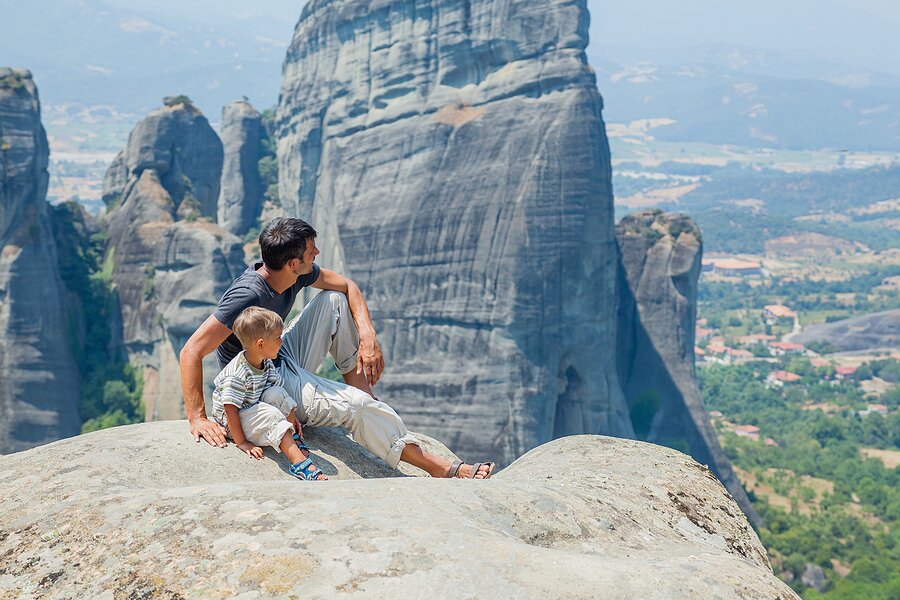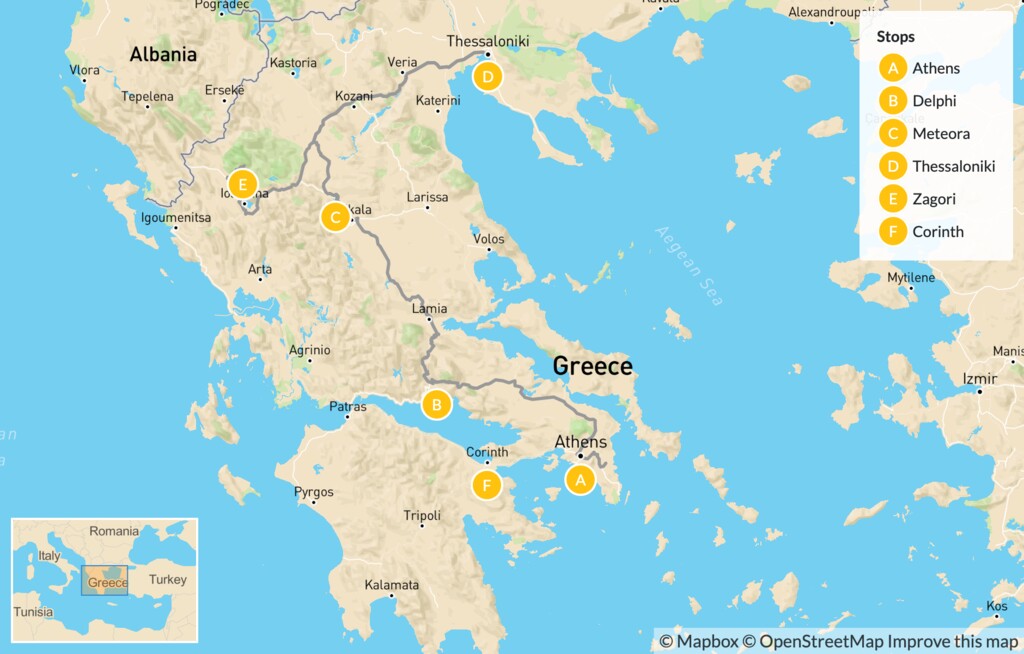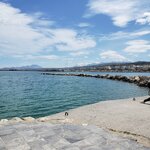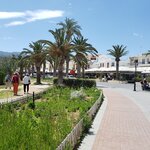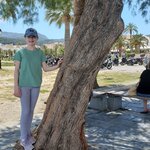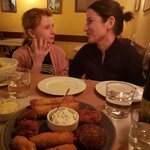Take two weeks to travel to some of Greece's lesser-visited landmarks and villages with this family-focused itinerary. Guided tours specifically designed for school-age children will help keep everyone engaged with stories from history and legend as you visit ancient monuments, gardens, and natural attractions. Start with the main sights in Athens, then hit the road up to the temples of Delphi, sky-high monasteries of Meteora, the northern bustle of Thessaloniki, and stone villages of Zagori.
Highlights
- Seek the ancient oracle at Delphi
- Tour the clifftop monasteries of Meteora
- Sample culinary specialties in Thessaloniki
- Experience rustic life in Zagori's stone villages
Brief Itinerary
| Day | Highlights | Overnight |
|---|---|---|
| Day 1 | Arrive in Athens & Explore Ancient Monuments | Athens |
| Day 2 | Botanical Garden Mythology Tour for Kids | Athens |
| Day 3 | Athens to Delphi & Kids' Activities on Mt. Parnassos | Delphi |
| Day 4 | Delphi Tour & Painting for Kids, Explore Galaxidi | Delphi |
| Day 5 | Delphi to Meteora | Meteora |
| Day 6 | Meteora Tour | Meteora |
| Day 7 | Meteora to Thessaloniki & Mythology Tour in Mt. Olympus Foothills | Thessaloniki |
| Day 8 | Food & Culture Tour in Thessaloniki | Thessaloniki |
| Day 9 | Beach Day at Chalkidiki | Thessaloniki |
| Day 10 | Thessaloniki to Zagori & Experience Rustic Zagori Life | Zagori |
| Day 11 | Family Hike in Zagori & Rafting the Voidomatis River | Zagori |
| Day 12 | Cooking Workshop in Zagori | Zagori |
| Day 13 | Natural Beauty of Aigialeia | Corinth |
| Day 14 | Depart Athens |
Detailed Itinerary
Day 1: Arrive in Athens & Explore Ancient Monuments

Welcome to Greece!
Once you've settled in at your lodgings, head out to experience Athens' unique blend of the ancient and the modern and admire major historical monuments on a relaxed walk. Follow Athens' famous walking route that connects its archaeological sections and marvel along the way at some of the city's most important and interesting sites. It's up to you whether you simply stroll around or purchase tickets for a deeper look at the sites.
Start outside the perimeter of the Temple of Olympian Zeus to admire the views and walk to the nearby Arch of Hadrian, which is entirely built with Pentelic marble without cement or mortar. The Parthenon and many other notable structures in Athens contain this same material. The arch is completely symmetrical, sitting at nearly 60 feet tall (18 m), 44 feet wide (13.5 m), and 7.5 feet deep (2.3 m).
Following the Dionysiou Areopagitou (pedestrianized) street, you'll admire the Ancient Theater of Dionysus, the birthplace of Greek tragedy and the oldest theater in the world. Then you will cross the Herodes Atticus Roman amphitheater, known locally as the Herodion.
Your next stop is the Parthenon, built in the 5th century BCE atop the Acropolis (pro tip: the Parthenon is the building, the Acropolis is the hill). Atop the Acropolis, you can also visit the Temple of Athena Nike, the Propylaia, and the Erechtheion. This monument is the most accurate representation of Athens' splendor, power, and wealth during the Golden Age of Perikles.
Located to the northwest of the Acropolis, you can visit the Ancient Agora, the heart of ancient Athens. This was once the focus of political, commercial, administrative, and social activity, the religious and cultural center, and the seat of justice. Nearby you'll find the Roman Agora, the famed market of Caesar and Augustus built between 19-11 BCE. Inside the Roman Agora, you can visit the Tower of the Winds. The famous astronomer Andronikos of Kyrrhos designed this tall, octagonal building. It features an elaborate water clock on the inside, a sundial on the outside, and a weather vane on the top. You'll find the personifications of eight winds carved on the sides of the building, hence its nickname.
Lastly, visit the ruins of Kerameikos, Ancient Athens' largest cemetery with many tombs. The area gets its name from the Greek word keramos, which means pottery. Before it was a cemetery, there were numerous pottery workshops at this site.
Start outside the perimeter of the Temple of Olympian Zeus to admire the views and walk to the nearby Arch of Hadrian, which is entirely built with Pentelic marble without cement or mortar. The Parthenon and many other notable structures in Athens contain this same material. The arch is completely symmetrical, sitting at nearly 60 feet tall (18 m), 44 feet wide (13.5 m), and 7.5 feet deep (2.3 m).
Following the Dionysiou Areopagitou (pedestrianized) street, you'll admire the Ancient Theater of Dionysus, the birthplace of Greek tragedy and the oldest theater in the world. Then you will cross the Herodes Atticus Roman amphitheater, known locally as the Herodion.
Your next stop is the Parthenon, built in the 5th century BCE atop the Acropolis (pro tip: the Parthenon is the building, the Acropolis is the hill). Atop the Acropolis, you can also visit the Temple of Athena Nike, the Propylaia, and the Erechtheion. This monument is the most accurate representation of Athens' splendor, power, and wealth during the Golden Age of Perikles.
Located to the northwest of the Acropolis, you can visit the Ancient Agora, the heart of ancient Athens. This was once the focus of political, commercial, administrative, and social activity, the religious and cultural center, and the seat of justice. Nearby you'll find the Roman Agora, the famed market of Caesar and Augustus built between 19-11 BCE. Inside the Roman Agora, you can visit the Tower of the Winds. The famous astronomer Andronikos of Kyrrhos designed this tall, octagonal building. It features an elaborate water clock on the inside, a sundial on the outside, and a weather vane on the top. You'll find the personifications of eight winds carved on the sides of the building, hence its nickname.
Lastly, visit the ruins of Kerameikos, Ancient Athens' largest cemetery with many tombs. The area gets its name from the Greek word keramos, which means pottery. Before it was a cemetery, there were numerous pottery workshops at this site.
Day 2: Botanical Garden Mythology Tour for Kids

Explore the myths and fables of the natural world inside the Ioulia & Alexandros N. Diomidis Botanical Garden.
At the largest botanical garden in the southeastern Mediterranean, you'll be surrounded by over 4,000 species and subspecies of plants. As you stroll through the greenery, learn about the relationship between humans, nature, and plants. According to Ancient Greek legends, gods, goddesses, and nymphs play with our imagination and travel around us in nature.
At the largest botanical garden in the southeastern Mediterranean, you'll be surrounded by over 4,000 species and subspecies of plants. As you stroll through the greenery, learn about the relationship between humans, nature, and plants. According to Ancient Greek legends, gods, goddesses, and nymphs play with our imagination and travel around us in nature.
This kid-friendly activity features a professional biologist who shares the stories of gods and goddesses. The ancient Greeks feared and worshipped nature, including the sea, sky, rivers, lakes, trees, and fountains, all designated as gods or mortals who changed shape to become a rock, a tree, or an animal. Listen to their various stories and learn the answers to questions within these stories, such as what connects the pine trees with Pitys and the relationship between the first feminist, Rodanthe of Corinth, and the roses.
At the end of the tour, you can stay and enjoy the gardens. The grounds are the perfect place for a family picnic and feature a well-protected playground.
Day 3: Athens to Delphi & Kids' Activities on Mt. Parnassos
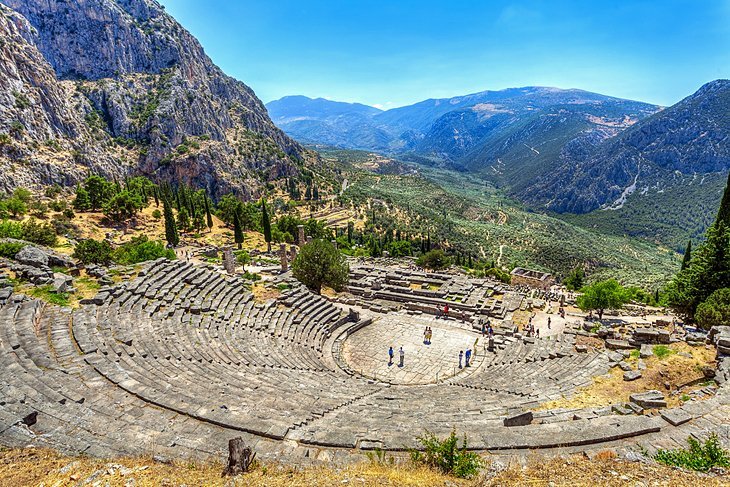
Enjoy a scenic drive from Athens to Delphi, which takes about two and a half hours toward the center of the mainland. The route leads you through rural farmland and along scenic Lake Yliki. As you near the town of Livadia, you'll pass the Springs of Kryas, lined with pedestrian areas and crossed by quaint stone bridges. If you're feeling hungry, you'll find a few restaurants and cafés nearby.
After Livadia, the road becomes narrow, winding through the hills and mountains. Before reaching Delphi, another potential stopping point is Arachova. This charming mountain village with stone-built houses and paved streets sits under Mt. Parnassos, home to Greece's largest ski resort and more.
After Livadia, the road becomes narrow, winding through the hills and mountains. Before reaching Delphi, another potential stopping point is Arachova. This charming mountain village with stone-built houses and paved streets sits under Mt. Parnassos, home to Greece's largest ski resort and more.
Once you arrive, let your little ones explore the nature around Delphi with an easy walk through the National Park of Mt. Parnassos. Established in 1938, the park encompasses Mt. Olympus and stands as one of the country's oldest national parks. Enjoy walking through the forest, in fields, and amongst the wildflowers with your babies, toddlers, and young kids.
You'll walk along a circular path smooth enough to accommodate strollers. Along the way, your kiddos can peer into the entrance of the underground Eptastomos Cave. Deep inside sits the southernmost glacier in Europe, but the Ancient Greeks considered it one of the entrances to the underworld.
Take a stop to enjoy a picnic with traditional delicacies while you get to know your guides. Discuss local traditions, try your hand at archery, or play and climb on the trees. You'll find two main tree species in this area: the Cephalonian Fir and the juniper tree.
On the way back, keep an eye out for little black squirrels hiding in pine trees and golden eagles soaring through the sky. The Ancient Greeks believed that Mt. Parnassos was the home of beautiful dancing forest nymphs that were the daughters of Gaia, also known as "Mother Earth."
You'll walk along a circular path smooth enough to accommodate strollers. Along the way, your kiddos can peer into the entrance of the underground Eptastomos Cave. Deep inside sits the southernmost glacier in Europe, but the Ancient Greeks considered it one of the entrances to the underworld.
Take a stop to enjoy a picnic with traditional delicacies while you get to know your guides. Discuss local traditions, try your hand at archery, or play and climb on the trees. You'll find two main tree species in this area: the Cephalonian Fir and the juniper tree.
On the way back, keep an eye out for little black squirrels hiding in pine trees and golden eagles soaring through the sky. The Ancient Greeks believed that Mt. Parnassos was the home of beautiful dancing forest nymphs that were the daughters of Gaia, also known as "Mother Earth."
Day 4: Delphi Tour & Painting for Kids, Explore Galaxidi

Discover the ancient archeological site of Delphi, known as the "center of the world," where Apollo spoke through his oracle. A family-friendly guide will lead you through this UNESCO World Heritage Site, set against a scenic mountain landscape. You'll explore the most sacred place of the ancient civilization while walking amongst ruins and learning all the secrets of the old prophecies.
As you discover different treasures of Delphi, you'll hear stories and myths of ancient Greek gods, goddesses, and heroes. Follow along the paths and view the Temple of Apollo, the Athenian Treasury, and the preserved Theater. Then, walk up to the stadium for stunning views of olive groves and the Corinthian Gulf.
After the tour, you'll explore your artistic skills and enjoy a unique painting workshop with a specialized guide. Choose your favorite scene of Delphi or its natural surroundings and work to create your own masterpiece. Your guide will help you learn a few painting techniques and offer advice as you work.
Once you've finished exploring Delphi, you'll head to the picture-perfect village and fishing port of Galaxidi, hidden in a picturesque bay on the northern side of the Gulf of Corinth.
Famous for the wonderfully restored old shipowners' mansions, the coastal town of Galaxidi makes you feel like you are on an island rather than on mainland Greece. Take a stroll down the seafront promenade and enjoy the sea breeze with beautiful views and a choice of cafes and restaurants for when you'll need a pit stop.
Plan your trip to Greece
Chat with a local specialist who can help organize your trip.
Chat with a local specialist who can help organize your trip.
Galaxidi is all about the locals, so grab any opportunity to engage in a discussion with the fishermen, the cafe staff, or little shop owners, they always have interesting stories to tell. Keep an eye out for the locally crafted miniature ships for a unique souvenir.
Day 5: Delphi to Meteora

Today you'll enjoy one of the most beautiful road trips in Greece from Delphi to Meteora, a drive of roughly 3.5 hours.
Over the course of the drive, you'll traverse the hilly Domokos mountain range. This area is known for its creamy white cheese called katiki. You can stop at most towns for a quick snack or take the cheese with you (remember to keep it cool along the way). Another potential stopping point is Trikala, considered the most ecologically and sustainably advanced city in Greece. A stroll in its picturesque old town of Varousi is worth the time.
Over the course of the drive, you'll traverse the hilly Domokos mountain range. This area is known for its creamy white cheese called katiki. You can stop at most towns for a quick snack or take the cheese with you (remember to keep it cool along the way). Another potential stopping point is Trikala, considered the most ecologically and sustainably advanced city in Greece. A stroll in its picturesque old town of Varousi is worth the time.
Once you arrive, settle into your lodgings and relax before you set out to explore Meteora's famous monasteries.
Day 6: Meteora Tour

Discover the incredible scenery and explore the centuries-old monasteries on a private tour of historic Meteora, either in the cool morning hours or in the evening for sunset views. Reaching heights close to 2,000 feet (600 meters), Meteora is one of Greece's most important monastic communities. Your local guide will take you through this UNESCO World Heritage Site and explain its geological, cultural, and historical significance.
Home to some of the oldest monasteries in Greece, Meteora rises out of imposing rock formations created 60 million years ago. Enjoy a guided tour of ninth-century monastic life that has been nearly unaffected by modern times. You'll visit all six monasteries and enter two or three of them (depending on which are open and conditions that day). Along the way, your guide will continue to share historical information, local knowledge, and insider specifics. They'll offer plenty of photo stops and a few short walking excursions for the best views and hidden vistas.
Home to some of the oldest monasteries in Greece, Meteora rises out of imposing rock formations created 60 million years ago. Enjoy a guided tour of ninth-century monastic life that has been nearly unaffected by modern times. You'll visit all six monasteries and enter two or three of them (depending on which are open and conditions that day). Along the way, your guide will continue to share historical information, local knowledge, and insider specifics. They'll offer plenty of photo stops and a few short walking excursions for the best views and hidden vistas.
Day 7: Meteora to Thessaloniki & Mythology Tour in Mt. Olympus Foothills

Enjoy a scenic three-hour drive from Meteora to Thessaloniki.
Along the way, you'll stop to explore Mt. Olympus and its surrounding monuments. Discover Greek mythologies and stories of Alexander the Great on this private history tour from Dion to Litochoro. You'll start with a visit to the village of Dion, set at the foot of the mountain, where archeologists have unearthed ruins from an ancient Macedonian civilization.
As you explore this archeological site, you'll hear stories of King Philip II and his son Alexander the Great, plus many other historical figures. View rare artifacts and visit sanctuaries of Olympic Gods and ancient Greek and Roman theaters.
Along the way, you'll stop to explore Mt. Olympus and its surrounding monuments. Discover Greek mythologies and stories of Alexander the Great on this private history tour from Dion to Litochoro. You'll start with a visit to the village of Dion, set at the foot of the mountain, where archeologists have unearthed ruins from an ancient Macedonian civilization.
As you explore this archeological site, you'll hear stories of King Philip II and his son Alexander the Great, plus many other historical figures. View rare artifacts and visit sanctuaries of Olympic Gods and ancient Greek and Roman theaters.
As you continue to Litochoro, your guide will answer the question of why people believed Mt. Olympus was the residence of the 12 Gods. Litochoro is a charming mountain town with incredible views. Your guide will take you on a short walking tour, then leave you with some free time to explore on your own. Relax and enjoy a traditional Greek coffee as you take in the scenery.
Once you arrive in Thessaloniki, take a relaxed walk through the city to take in its ancient Macedonian, Roman, Byzantine, and Ottoman architecture. Start from the White Tower, the city's most famous attraction, with family-friendly pavement and sidewalks along the coastline with easy access to historical sites towards the center of the city and the coastal promenade. Or take a stroll on the seaside promenade of Nea Paralia, which extends from the White Tower to Megaro Mousikis concert hall. The path takes you through beautiful thematic parks, where you can have a picnic or play with kids, as well as the children’s traffic park and other unique playgrounds and spots ideal for your family to rest for a while.
Day 8: Food & Culture Tour in Thessaloniki

Discover Thessaloniki through your tastebuds on this delicious four-hour food tour through the city. Your guide has extensive knowledge of Greek food and culture and is excited to share it with you! You'll eat your way through breakfast and lunch like a local, learning about Greek food, customs, and traditions.
You'll start your day with a traditional Greek coffee and a sweet pastry called bougatsa, a typical breakfast for any local city dweller. Then, you'll walk around Thessaloniki, making several short stops to try different delicacies and learn the history and culture of Greek cuisine. Get a behind-the-scenes look at bakeries, grills, restaurants, cafes, and food shops. Along the way, you'll enjoy a total of four drinks and 14 bites of sweet and savory specialties.
Before ending your tour, stop at the city's lively open market. Here, you'll discover local culture and unique traditional flavors. Chat with the farmers and artisans, and buy some foodie souvenirs to take home.
You'll start your day with a traditional Greek coffee and a sweet pastry called bougatsa, a typical breakfast for any local city dweller. Then, you'll walk around Thessaloniki, making several short stops to try different delicacies and learn the history and culture of Greek cuisine. Get a behind-the-scenes look at bakeries, grills, restaurants, cafes, and food shops. Along the way, you'll enjoy a total of four drinks and 14 bites of sweet and savory specialties.
Before ending your tour, stop at the city's lively open market. Here, you'll discover local culture and unique traditional flavors. Chat with the farmers and artisans, and buy some foodie souvenirs to take home.
The rest of the day is yours to spend as you wish. Get onboard one of the small wooden ships anchored in the White Tower area and sail away around Thermaikos Gulf, or stay on land with a walk in the city center through Aristotelous Square and Navarinou.
Thessaloniki is also home to multiple museums. Around the city port, you'll find the Museum of Photography, the State Museum of Contemporary Art, and the Thessaloniki Film Museum. In the city center, head to the Archaeological Museum of Thessaloniki, the Museum of Byzantine Culture, or the War Museum depending on your family's interests.
Day 9: Beach Day at Chalkidiki

Chalkidiki is a picturesque region and peninsula southeast of Thessaloniki with three "legs" that jut out into the Aegean Sea. The area offers incredible beaches, many with crystal-clear waters away from currents. It's an ideal location for a relaxing day at the seaside.
Mostly protected from winds, the beaches of Chalkidiki feature shallow, turquoise waters. For the best experience, drive along the eastern side of the "second leg" (as the locals call it). You'll have plenty of options for beaches with perfect swimming conditions and beautiful surroundings. The Vourvourou, Armenistis, and Kavourotrypes beaches are all excellent choices.
Continue clockwise and make your next stop at Porto Koufo, an oddly shaped bay that creates what looks like an enclosed sea. Although not ideal for a swim, it's the perfect spot for lunch, with some of the best fish taverns in Chalkidiki.
On your way back to Thessaloniki, stop at Nikiti and take home the delicious revani (sweet cake with orange and rose flavors) accompanied by their special ice cream called dondurma.
Mostly protected from winds, the beaches of Chalkidiki feature shallow, turquoise waters. For the best experience, drive along the eastern side of the "second leg" (as the locals call it). You'll have plenty of options for beaches with perfect swimming conditions and beautiful surroundings. The Vourvourou, Armenistis, and Kavourotrypes beaches are all excellent choices.
Continue clockwise and make your next stop at Porto Koufo, an oddly shaped bay that creates what looks like an enclosed sea. Although not ideal for a swim, it's the perfect spot for lunch, with some of the best fish taverns in Chalkidiki.
On your way back to Thessaloniki, stop at Nikiti and take home the delicious revani (sweet cake with orange and rose flavors) accompanied by their special ice cream called dondurma.
Day 10: Thessaloniki to Zagori, A Taste of Zagori Rustic Life
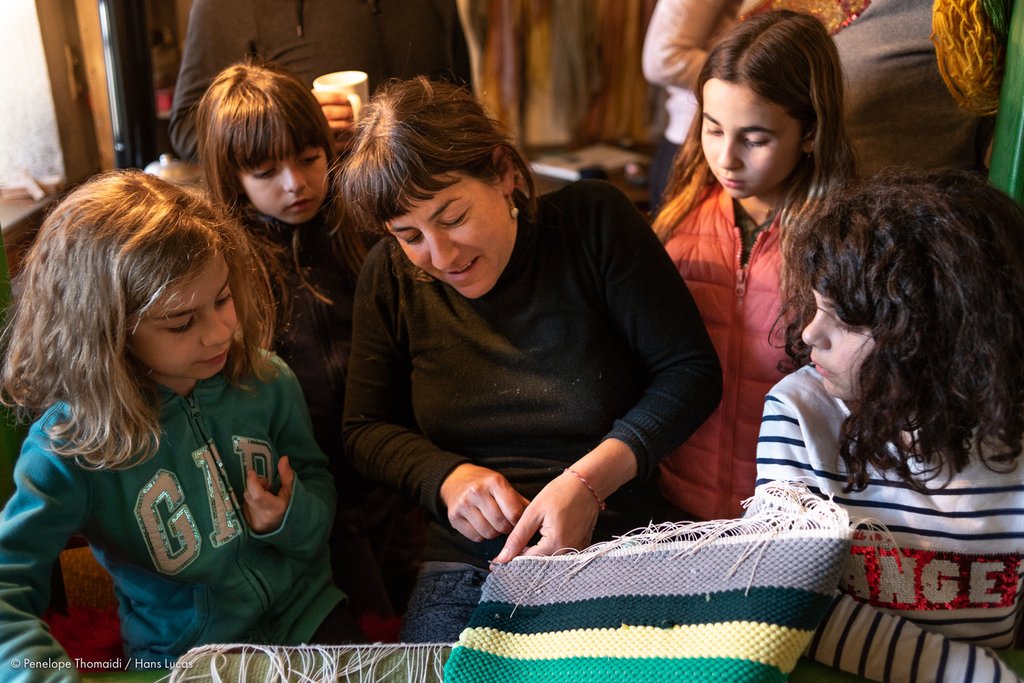
Enjoy a scenic drive from Thessaloniki to Zagori, a trip of about 4.5 hours. Head southwest and enjoy views of the purple saffron fields near Kozani. Consider a short detour to the charming town of Naoussa, surrounded by nature and famous for the local grape variety Xinomavro. This grape produces some of the best wines in Greece, especially aged varieties.
Once you arrive in Zagori, set out to experience what life is like for the inhabitants of these stone villages. This family-friendly activity takes place in the traditional cottage of a historic 19th-century mansion as your host helps you understand life in Zagorochoria (the 46 villages of Zagori).
In Zagori, life is simple and slow-paced. To start, you'll learn to weave on a traditional loom and make a natural tincture to dye wool, as the locals still do. Then, discover the process of felt and create your own keepsakes, such as a little cushion or decorative frame.
Next, you'll meet the cottage's chickens and collect the day’s eggs to make a traditional Zagori pie. Your guide will need your help making bread for the day, so you'll test your skills kneading the dough and watching it bake in the oven. After all your hard work, you'll enjoy a fresh meal in the peaceful garden.
In Zagori, life is simple and slow-paced. To start, you'll learn to weave on a traditional loom and make a natural tincture to dye wool, as the locals still do. Then, discover the process of felt and create your own keepsakes, such as a little cushion or decorative frame.
Next, you'll meet the cottage's chickens and collect the day’s eggs to make a traditional Zagori pie. Your guide will need your help making bread for the day, so you'll test your skills kneading the dough and watching it bake in the oven. After all your hard work, you'll enjoy a fresh meal in the peaceful garden.
Day 11: Family Hike in Zagori & Rafting the Voidomatis River

Discover Zagori's historic stone bridges and picturesque villages with this easy, family-friendly hike, perfect for kids. This unique region features 46 villages, the Pindos Mountains, roaring rivers, and deep gorges. You'll follow your guide along the old footpaths that link the hamlets, once the only connection before roads were built.
This circular hike starts in the town of Kipi, home to some of the most impressive stone bridges of the area. Many originate in the 17th and 18th centuries and feature the name of whoever paid for the construction. Upon reaching the village of Koukouli, you'll visit the Lazaridis Museum and observe an expansive collection of the rare flora found in Vikos Gorge.
As you head back to Kipi, follow the old stone path of Koukouli, also known as the "Koukouli Steps." Opt for a stop at the 16th-century Monastery of Pagia Spiliotissa for some extra exploring. The views are worth your time, as the structure sits atop a rock overlooking the Voidomatis River.
This circular hike starts in the town of Kipi, home to some of the most impressive stone bridges of the area. Many originate in the 17th and 18th centuries and feature the name of whoever paid for the construction. Upon reaching the village of Koukouli, you'll visit the Lazaridis Museum and observe an expansive collection of the rare flora found in Vikos Gorge.
As you head back to Kipi, follow the old stone path of Koukouli, also known as the "Koukouli Steps." Opt for a stop at the 16th-century Monastery of Pagia Spiliotissa for some extra exploring. The views are worth your time, as the structure sits atop a rock overlooking the Voidomatis River.
Next, get up close with the river on an easy rafting adventure and ride a series of white rapids as you descend into the Voidomatis River Valley in the Vikos-Aoos National Park.
After a short introduction and safety briefing, you'll transfer to your starting point at the Aristi-Papigo Bridge. Along the way, enjoy views of Mt. Tymphi, the Astraka towers, and the village of Papigo. As you paddle down the river, stop to admire the 16th-century Agioi Anargyroi Monastery. You'll also glide under the old Klidonia stone bridge, over a small artificial waterfall, and enjoy plenty of time to swim in the river pools.
The river runs through the area's famous Vikos Gorge, following a route lined with old plane trees and traditional stone bridges. As the river merges with the Aoos River in the Konitsa Valley, you'll find one of Greece's most stunning natural environments. Enjoy views of dense forests, steep mountain cliffs, and deep ravines.
Day 12: Cooking Workshop in Zagori
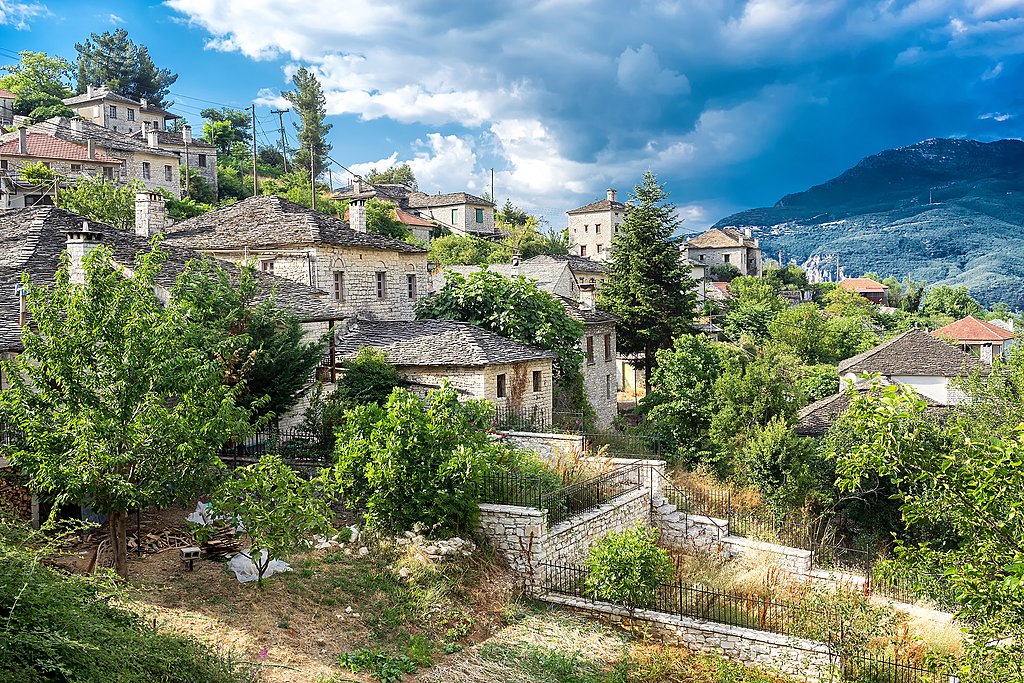
Discover the unique flavors of the Zagori region in this cooking workshop. You'll use fresh and local ingredients, most produced in a nearby greenhouse. When finished, you'll savor a feast of luscious pies and salads, meats and cheeses, and desserts.
As you and your personal chef prepare a full three-course meal, you'll learn the conventional techniques and secrets behind the kitchen's inherited recipes. Discover Zagorian culinary traditions that make this rich-tasting cuisine famous all across the country before you enjoy your well-deserved meal with a glass of local wine (for parents only) and mountain views.
As you and your personal chef prepare a full three-course meal, you'll learn the conventional techniques and secrets behind the kitchen's inherited recipes. Discover Zagorian culinary traditions that make this rich-tasting cuisine famous all across the country before you enjoy your well-deserved meal with a glass of local wine (for parents only) and mountain views.
Day 13: Natural Beauty of Aigialeia
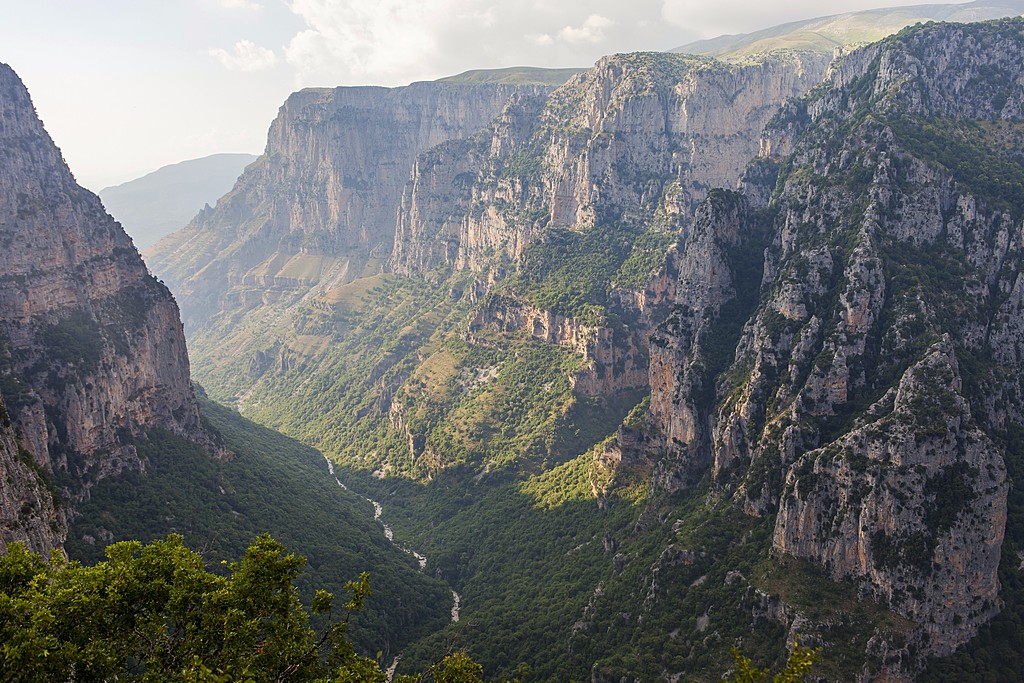
Today you'll explore the beauty of the Aigialeia region, situated by the northern tip of the scenic Peloponnese. You can start with the Odontotos Railway, a steep mountain railway that takes you to the alpine town of Kalavryta through the impressive Vouraikos Gorge. Many visitors opt to hike part of the distance (usually from Zachlorou to Kalavryta, or vice versa) to fully enjoy the area's natural beauty. Still, the railway alone will give you incredible panoramic views of the gorge and Aigialeia's scenic landscapes.
An alternative to the railway is driving to Mt. Helmos, allowing you to lose yourself amongst endless alpine forests and creeks. This drive is ideal for hot summer days but can be done any time of year with the right equipment. Stop to enjoy an easy trek to the waterfalls near Mesorougi village, whose waters flow down from Ydata Stygos, the spring where Achilles became immortal.
Whether you chose a railway adventure or a hiking excursion, you can end the day with a visit to a highly awarded olive farm in the village of Akrata. Relax in the shade of olive trees and absorb the amazing views of the Gulf of Corinth. You can even adopt an olive tree and receive its olive oil at home.
An alternative to the railway is driving to Mt. Helmos, allowing you to lose yourself amongst endless alpine forests and creeks. This drive is ideal for hot summer days but can be done any time of year with the right equipment. Stop to enjoy an easy trek to the waterfalls near Mesorougi village, whose waters flow down from Ydata Stygos, the spring where Achilles became immortal.
Whether you chose a railway adventure or a hiking excursion, you can end the day with a visit to a highly awarded olive farm in the village of Akrata. Relax in the shade of olive trees and absorb the amazing views of the Gulf of Corinth. You can even adopt an olive tree and receive its olive oil at home.
You'll spend the night in a seaside village along the Gulf to make sure you're close enough to the airport for tomorrow's flight, while still enjoying a relaxing last evening's coastal views.
Day 14: Return to Athens & Depart

Wave goodbye to Greece as you catch your flight home or onto your next adventure.
